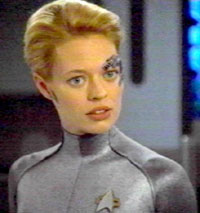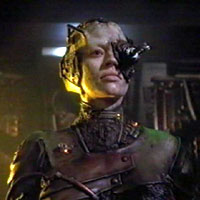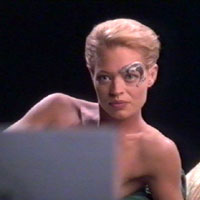Seven of Nine

Seven of Nine (VOY-171)

Seven of Nine (VOY-169)

Seven of Nine (VOY-186)

Seven of Nine (VOY-218)

Seven of Nine (VOY-221)

Seven of Nine (VOY-224)
Assimilated at the age of six, Seven of Nine spent most of her life as a Borg drone until she encountered the U.S.S. Voyager NCC-74656. The former Borg drone, Seven of Nine, was born a human female named Annika Hansen.[3] Her parents, Magnus and Erin, were citizens of the United Federation of Planets; they were famously unconventional scientists and had a reputation for radical methods. They developed an interest in the Borg years before the U.S.S. Enterprise NCC-1701-D made contact with them, and applied for permission to study the biomechanical species in the early 2350s.[17]
The Hansen family conducted their research aboard a civilian science vessel, the S.S. Raven NAR-32450,[7] a small interstellar spacecraft that could be operated by a crew of two. In 2350, the Raven left space station Deep Space Four on an expedition to find and study the Borg. Annika’s parents took her with them on their missions. The small child lived on the Raven for just over three years, and had virtually no contact with other humans.[17]
The last reported sighting of the Raven placed it in the Omega sector; after contact was lost, it was eventually listed as missing, presumed lost. In reality, the Hansens had found a Borg cube and followed it into a transwarp conduit. When the Raven emerged on the other side, it was in the Delta Quadrant.[17]
The Hansens continued to track the Borg for more than two years before a cube eventually detected them.[18] The resultant attack caused the ship to crash land on a Class-M moon in B’omar space, and the Hansen family was overwhelmed when Borg drones boarded their ship; the six-year-old Annika and her family were assimilated. The Raven was also partially assimilated, and its ruined hulk was altered to transmit a Borg resonance signal.[7]
Annika’s identity was swept away by the assimilation process, and she was eventually redesignated as Seven of Nine, Tertiary Adjunct of Unimatrix Zero One. She swiftly became a fully fledged member of the Borg, her body radically adapted and modified by the presence of Borg nanoprobes.[1]
Because Seven became a Borg drone at such a young age, she never had the chance to develop into a normal Human adult or to forge any healthy Human friendships or relations—facts that later impeded her interactions with Humans. In the interim, she served aboard a Borg cube and became part of the collective’s vast group mind, participating in many operations and attacks on species throughout the Delta Quadrant. She also took part in the Borg’s attacks on the Alpha Quadrant, and assimilated members of the Vulcan, Human, and Ferengi races.[16] Stripped of any Human doubts or frailties, Seven continued to perform her functions and duties efficiently as a Borg drone for 18 years.[3]
In 2368, Seven was on a Borg sphere that crash landed on the surface of a planet. Seven and three other members of her unimatrix survived the crash, but they were disconnected from the collective. As a result, their individual memories began to resurface, but whereas the other drones remembered being fully formed adults with strong identities, Seven could only remember being a scared child. She found the experience extremely uncomfortable and was desperate to return to the collective. The other drones reacted very differently—they were pleased to be free from the Borg and had no desire to be reassimilated. In order to protect themselves they destroyed the homing beacon that was summoning the Borg. When Seven saw the death of a fifth drone who had barely survived the crash, she panicked and decided to suppress the other three survivors’ individual personalities. She did this by infiltrating their left cerebral hemispheres with nanoprobes to create a new organic interlink node which joined them together permanently. Shortly afterward, all four drones were returned to the Borg collective and reassimilated.[20]
In 2373, the collective was attacked by savage other-dimensional beings from fluidic space, whom the Borg designated Species 8472. This race proved to be not only resistant to the Borg’s assimilation process but capable of destroying Borg cubes and even entire Borg worlds. When Captain Kathryn Janeway of the U.S.S. Voyager NCC-74656 contacted the Borg with the promise of information on how to defeat Species 8472 in return for safe passage through Borg space, a temporary alliance was forged. Janeway asked the Borg to communicate with her through a single drone, and the collective chose Seven. She acted as a “mouthpiece” for the Borg in much the same way that Locutus (formerly Starfleet Captain Jean-Luc Picard) did in 2366, and presented Janeway with the Borg’s demands for assistance against the aliens.[1] Another attack by Species 8472, however, destroyed the Borg vessel, and Seven and a team of drones boarded Voyager. Ultimately, Seven was the sole surviving Borg after her fellow drones were ejected from the ship by Commander Chakotay.[2]
Voyager‘s crew were forced to disable the neurotransciever in Seven’s upper spinal column to prevent her from contacting other Borg vessels. When they did this, they severed her connection to the collective. Suffering forced separation, Seven went into shock, and her Borg implants began to break down as her original Human physiology started to regain dominance. After spending some time unconscious, Seven awoke and demanded to be returned to Borg space. When Janeway refused, Seven asked to be left off at the nearest available planet with a subspace transmitter so that she could contact the Borg. Again Janeway refused, and instead ordered Voyager‘s Emergency Medical Hologram to remove most of Seven’s Borg implants, including several of her biochip units. This measure was medically necessary as her human and Borg elements were in constant conflict, endangering her life.[3]
Her original human skin tone and blonde hair were regrown using dermaplastic grafts and follicle stimulation techniques, leaving only a few implants visible around her eyes, ears, and left arm. During these operations the Doctor removed 82 percent of Seven’s Borg hardware. Her outward appearance changed so that she looked like a normal human, but she retained many of the Borg’s superior physical and mental enhancements.[3] Seven’s outer epidermal skin layer was still capable of withstanding energy discharges and damage that would otherwise severely injure a normal human; she also retained an ability to quickly compute and absorb information,[21] while her optical and aural implants continued to process input from spectra of light and sound beyond the normal human range.[8] Physically, she remained much stronger than a human of her size and body mass, and she also retained Borg technologies such as extendible assimilation tubules, and a bloodstream containing self-replicating nanoprobes. The nanoprobes were dormant but had the potential to reassimilate her at least partially. When this happened a few months after she joined the ship, she developed the ability to generate Borg shields that could resist phaser fire.[7]
Although Seven had been disconnected from the Borg collective, she remembered large amounts of information and data from the Borg’s colossal databanks, stored within the neuroprocessor implants that were still present in her brain. The reversion was a far from painless process, and on several occasions Seven suffered from hallucinations—caused by her borg implants and awakening memories.
Both Seven and Janeway’s crew assumed that the Borg had been unwilling to sever their links with her. However, the Borg Queen claimed to have deliberately placed Seven aboard Voyager in an attempt to learn more about the Federation—a culture that had successfully resisted repeated Borg attacks, though the validity of that claim is highly dubious.[18]
Seven did not find it easy to adapt to life among a community of individuals, and it continued to be an ongoing, difficult journey for her. To use an old Earth analogy, she was the equivalent of a feral orphan child raised by wolves, and she did not consider herself to be human in any way. This was why she felt it was inappropriate to use her original name, Annika, and chose to be known as Seven. At first, Seven was very much against the concept of losing her Borg identity (such as it was), and she considered the idea of individuality terrifying and abhorrent. She was used to hearing many voices in her head as a Borg drone, and never suffered indecision or loneliness. She felt that as a Borg she had lived a life of clarity and harmony in pursuit of one purpose: to serve the collective.[3]
In the early stages of her reversion, she accused Captain Janeway of denying her the right to her own self-determination, and she constantly demanded to be put off Voyager. When her requests were refused, she made several attempts to escape, most notably when she was guided to the crash site of the Raven by a Borg resonance signal. It was there that she remembered her initial assimilation and the terror she felt as a human child, an experience that lessened her desire to reintegrate with the Borg. After this incident, she made no further attempts to return to the Borg.[7] Despite her desire to leave Voyager, Seven’s Borg nature gave her an inherent tendency to follow orders and to place the good of the whole above her individual safety. Even before she visited the Raven, she helped the crew to restore partially assimilated parts of the ship, and she offered to surrender herself to the Caatati to protect the rest of the crew.[5]
Although Seven’s experiences on the Raven awakened her memories of childhood, she continued to feel uncomfortable about her past and did not examine her parents’ logs for more than a year. Even then, she only did so under pressure from Captain Janeway, who wanted to know how the Hansens had avoided detection by the Borg. When Seven did read their logs, it was clear that she blamed her parents for being overconfident and ultimately condemning her to life as a Borg.[17]
Living in Human society again, Seven experienced difficulties with human interaction beyond the Borg’s simple “yes-no” processes, but physiologically she began to improve. In the first few months of her adapted Human-Borg hybrid state aboard Voyager, she exclusively used a Borg alcove to regenerate and nourish herself instead of eating and sleeping in the conventional human sense. The alcove, an item of Borg technology transported to Voyager during its initial encounter with Seven’s cube, was an access terminal that linked Borg drones to the collective and their ship’s power source; Seven modified it to allow her to draw sustenance from Voyager, but as time passed she also began to ingest food in the conventional human manner.[9] The Doctor, having himself been through the trials of understanding human life, took it upon himself to become a mentor, educating Seven in social protocols as a form of emotional maintenance in addition to his other chores of monitoring her Borg implants. But Seven continued to be confused by the apparent irrelevancy of human social customs such as politeness and courtesy, casual conversation, and sexual liaison.[6]
Nevertheless, she proved to be an extremely useful member of the crew. Her knowledge enabled her to work on several development projects with Voyager‘s crew, from the failed attempt to open a Borg transwarp conduit[5] to the development and implementation of the new astrometrics lab, (VOY-) and the creation of the Delta Flyer using cannibalized Borg technology.[15]
As Seven’s sense of identity grew, she realized that she must win the trust and respect of Captain Janeway and the Voyager crew, but at the same time she resented the blocks placed on her freedom of expression and had an unerring belief that she was always right. During Voyager‘s encounter with an Hirogen hunter in search of a lone member of Species 8472, Seven argued against Janeway’s humanitarian desire to rescue the injured alien, favoring the idea of turning the creature over to the Hirogen to save the ship. When Seven did exactly that, directly against Janeway’s express orders and ignoring the command structure, her privileges and freedom aboard the ship were severely curtailed. She argued that her act, an example of individual choice, proved that she was becoming more human.[10]
Another incident occurred when Captain Janeway was trying to carry out Federation policy in destroying the Omega molecule, a highly dangerous source of unimaginable power that was capable of ripping a hole in the fabric of space. Seven was very much against this decision; for the Borg, the Omega molecule represented perfection and was their “holy grail.” Once Seven believed she had found a way to stabilize it, she thought Janeway would allow her to proceed. Janeway, however, did not, and Seven was prepared to defy her orders and endanger the lives of the crew in her attempt to stabilize the molecule. Ultimately she followed the captain’s orders, but she still believed that as a Borg she was superior to her crewmates and capable of making better decisions than her captain.[12]
Despite her faith in the Borg’s perfection, Seven soon discovered that she was not infallible. One one occasion she clearly recalled an incident in which an alien, Kovin, had removed nanoprobes from her bloodstream. It emerged that her memories were false, but Kovin died fleeing a trial. Seven was distressed both by her own fallibility and his death.[11]
In many ways, Seven’s development mirrored that of a Human being’s passage through puberty into adulthood, with the accompanying changes in physical and emotional states, and the conflicts that arise between youth and authority; she could be seen as the unruly, growing teenager to Janeway’s stern but concerned parent. Another aspect of her new life that Seven has found difficult to cope with has been the loneliness that accompanies Human individuality. As a component of the Borg collective’s group consciousness of billions of minds, she grew up to see herself as part of a greater whole, and was comforted by the hive-like society of her fellow drones. She went from being one mind among a collective of billions to a lone individual among a mere few hundred people, and the process was hard on her. In 2374, when she was forced to become the sole conscious crew member aboard Voyager, she sufered a crisis of confidence and a mental breakdown that almost cost her life and that of the crew.[13] As she spent time living among the Voyager crew, Seven’s attitude toward the Borg began to shift. As her personality developed, she began to value her individuality, and started to feel that the Borg had been far from perfect. She came to regard Voyager as “her collective” and started to form friendships with several crew members. She developed particularly strong relationships with Captain Janeway, who made it a personal mission to educate her, the Vulcan Tuvok, whose logical approach she found far easier to understand than the “irrational” Humans, and the Doctor, whose own experience of “becoming human” mirrored her own.
The crew tried to persuade Seven to explore her individuality. Captain Janeway convinced her to experiment with her creativity by introducing her to a holodeck program that was set in Leonardo da Vinci‘s workshop. At first Seven could not see the point in art, but she eventually began to experiment with sculpture.[4] For his part, Neelix encouraged her to eat food and experiment with various cuisines. (VOY-) The Doctor’s attempts to educate Seven about Human interaction were especially significant. One particular course focused on romantic relationships. When Seven began to study mating behavior, the Doctor and Captain Janeway suggested that she go on a date. Seven found it extremely difficult to develop her “dating” skills; she chose her clothes based on their practicality, and found small talk irrelevant. Nevertheless, she persevered, and, with the Doctor’s guidance, succeeded. When Seven discovered that the Doctor had taken a wager with Tom Paris on her success, her feelings were hurt—perhaps for the first time. She forgave the Doctor, but decided that there were no suitable mates for her aboard Voyager and terminated the lessons.[19]
By mid-2374, Seven’s attitude to the Borg had changed radically. During an emergency transport, several of her nanoprobes infected the Doctor’s portable holographic emitter and created a Borg drone with access to the emitter’s 29th-century technology. This drone had no sense of identity or knowledge of the other Borg. Seven took on the role of parent to the drone who named himself One. She told him that individuality was preferable to life within the Borg’s hive mind. Despite his interest in the Borg, One accepted her teaching and ultimately sacrificed his life to protect Voyager from the collective. Seven was saddened by the experience, which had a profound effect on her.[14]
Not long afterward, Voyager encountered a Borg cube that had been destroyed by a specially engineered computer virus. The telemetric virus worked by infecting each drone’s neuroprocessor and making the dormant memory engrams of the individuals the drone had assimilated active. Seven was infected with the virus and developed the Borg equivalent of multiple personality disorder. The assimilated personalities threatened to overwhelm her sense of identity, and she only survived by acknowledging the different personalities within her. The experience awakened several desires and led to her forming a close friendship with Naomi Wildman, the only child aboard Voyager.[16]
Naomi was only slightly younger than Seven had been when she was assimilated. Through their friendship, Seven was able to explore aspects of the childhood that had been taken from her by the Borg; for example, they played the child’s game Kadis-Kot together. Seven and Naomi established a strong rapport, eventually coming to consider one another as family. Perhaps the most significant event happened when Seven was captured by the Borg and given a chance to return to the collective. She was taken to the heart of the Borg unicomplex, where the Borg Queen asked her to willingly contribute her experience of Humanity into the Borg. This would have involved reassimilating her in a way that allowed her to retain aspects of her individuality.[17] Seven completely rejected the offer and did everything in her power to prevent the Borg from assimilating Species 10026. Captain Janeway eventually rescued her and took her back to Voyager.[18]
Seven also demonstrated her devotion to individualism in 2375, when she encountered the members of her unimatrix whom she had forcibly assimilated years earlier. The way that she had linked them together meant that they were constantly aware of one another’s thoughts, even though they had escaped from the collective. They did not understand what had happened to them and hoped that Seven could provide them with the answer. Seven agreed to help them, but she had no memory of the events herself. It emerged that the collective had suppressed all their memories surrounding the “assimilation.” Seven and the former drones were able to retrieve their memories by forming a neural link, but the procedure left the other three drones in a coma. The Doctor told Seven that there were only two options: either return the former drones to the Borg, where they would live for many years, or remove their micro-cortical implants, without which they would only live for a matter of weeks. Seven was extremely distressed to learn what had happened. By this time she had so thoroughly rejected the Borg that she felt a few short weeks of individuality were preferable to a long life as a member of the collective, so she told the Doctor to sever the link.[20]
Evolving, changing, and growing into her new way of being was as painful a process for her as it was for the crew. She had little experience outside of life in the Borg collective; she did not enjoy food or drink for its own sake, was never seen relaxing, and had not yet found love. Trust did not come easily to her, and resentment over her former Borg status was still an issue among some members of the ship’s crew. Despite this, Seven proved her worth as part of the team, saving the ship on several occasions and, slowly but surely, beginning to fit in. When she was first brought aboard, Captain Janeway agreed that if she wished to return to the collective after she had regained her humanity, she would be allowed to do so; but she turned her back on the Borg, and it seemed that with every step she took toward regaining the Human heritage of Annika Hansen, Seven grew beyond the nature of the Borg into something that combined aspects of both the Borg and Humankind. Portrayed by Jeri Ryan.
References
- 1. “Scorpion.” Star Trek: Voyager, Episode 168. Television. 21 May 1997.
- 2. “Scorpion, Part II.” Star Trek: Voyager, Episode 169. Television. 3 September 1997.
- 3. “The Gift.” Star Trek: Voyager, Episode 170. Television. 10 September 1997.
- 4. “Nemesis.” Star Trek: Voyager, Episode 171. 24 September 1997.
- 5. “Day of Honor.” Star Trek: Voyager, Episode 172. Television. 17 September 1997.
- 6. “Revulsion.” Star Trek: Voyager, Episode 173. Television. 1 October 1997.
- 7. “The Raven.” Star Trek: Voyager, Episode 174. Television. 8 October 1997.
- 8. “Scientfic Method.” Star Trek: Voyager, Episode 175. Television. 29 October 1997.
- 9. “Year of Hell, Part I.” Star Trek: Voyager, Episode 176. Television. 5 November 1997.
- 10. “Prey.” Star Trek: Voyager, Episode 184. Television. 18 Feb 1998.
- 11. “Retrospect.” Star Trek: Voyager, Episode 185. Television. 25 February 1998.
- 12. “The Omega Directive.” Star Trek: Voyager, Episode 189. Television. 15 April 1998.
- 13. “One.” Star Trek: Voyager, Episode 193. Television. 13 May 1998.
- 14. “Drone.” Star Trek: Voyager, Episode 196. Television. 21 October 1998.
- 15. “Extreme Risk.” Star Trek: Voyager, Episode 197. Television. 28 October 1998.
- 16. “Infinite Regress.” Star Trek: Voyager., Episode 203. Television. 25 November 1998.
- 17. “Dark Frontier, Part I.” Star Trek: Voyager, Episode 211. Television. 17 February 1999.
- 18. “Dark Frontier, Part II.” Star Trek: Voyager, Episode 212. Television. 17 February 1999.
- 19. “Someone to Watch Over Me.” Star Trek: Voyager, Episode 216. Television. 28 April 1999.
- 20. “Survival Instinct.”.” Star Trek: Voyager, Episode 222. Television. 29 September 1999.
- 21. “The Voyager Conspiracy.” Star Trek: Voyager, Episode 229. Television. 24 November 1999.
Leave a Reply
Categories
- Animated Series (60)
- Articles (28)
- Books (447)
- Cast & Crew (79)
- Comics (22)
- DS9 (328)
- Early Voyages (125)
- Education (5)
- Enterprise (373)
- Excelsior (36)
- Food (19)
- Games (223)
- Klingon (70)
- Library (1,543)
- Logs (593)
- Lost Era (55)
- Medicine (18)
- Merrimac (1)
- Mirror (35)
- Miscellaneous (13)
- New Frontier (54)
- Next Generation (635)
- Original Series (681)
- Personnel (436)
- Places (369)
- Politics (12)
- Recreation (10)
- SCE (41)
- Science (1)
- Shatnerverse (9)
- Ships (455)
- Site Updates (98)
- Starfleet Academy (86)
- Stargazer (42)
- STO (61)
- Technology (45)
- Titan (59)
- To Boldly Go (1)
- TV/Film (214)
- Uncategorized (4)
- Vanguard (76)
- Voyager (236)
- Weapons (27)
- Xenology (54)